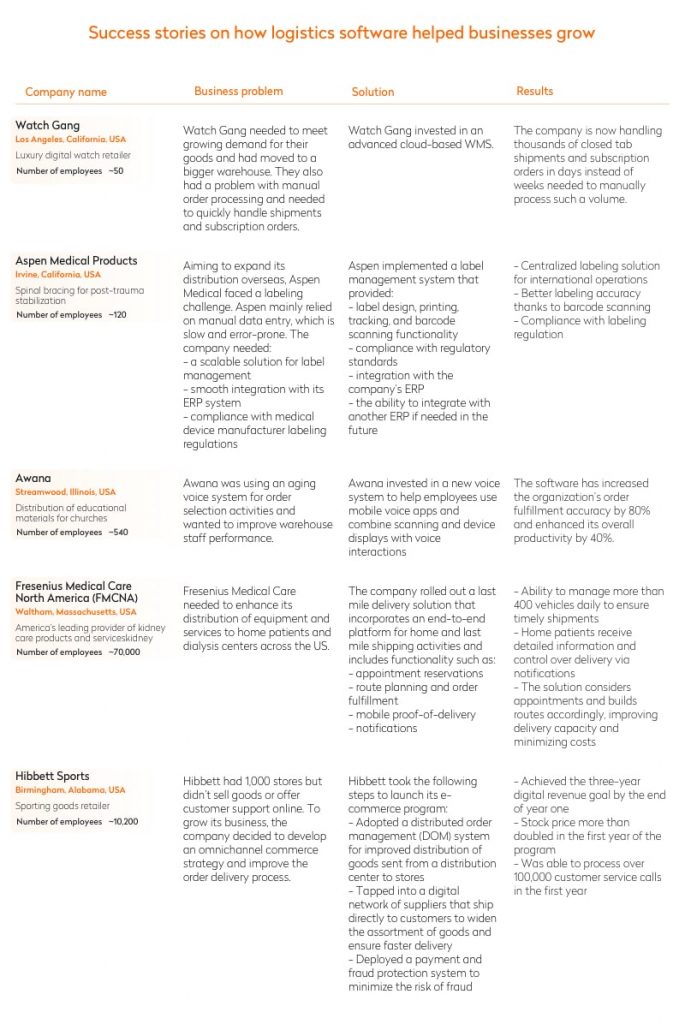Finding the most cost-effective ways to provide exceptional customer experience is the top priority in logistics. Leading logistics companies seek new approaches to deal with the rising demand and customer expectations, and thus try out new technology solutions to optimize logistics management.
To stay afloat in the crowded industry, logistics businesses have no choice but to use digitalization logistics best practices to automate their processes. When processes are automated, all the data you need for planning and predictions is available and properly processed, resources are optimized, and you can make reasoned decisions that align with your company’s strategy.
The logistics industry is multifaceted, and there are a mind-blowing number of software solutions. How can you decide which to use? We are here to help you. In this guide, we'll show how with the help of root cause analysis you can find possible challenges and opportunities your business has. Then, we'll list the most popular types of software that can help you with solving the issues you've found. But first, look at the table below to know how software upgrades helped several companies improve their supply-chain performance.
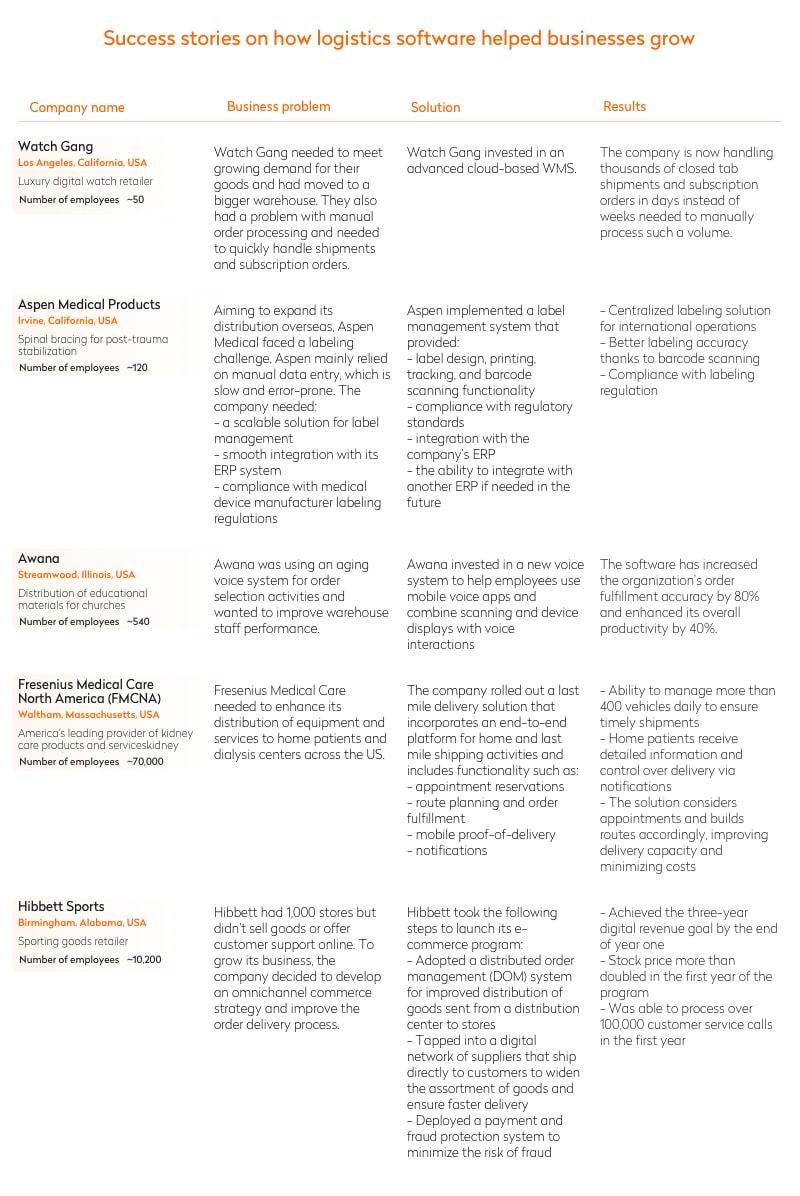
What you should consider before choosing any logistics software
Only the wearer knows where the shoe pinches. Begin your search for logistics software with figuring out your own processes and identifying issues within them.
We won’t describe all the possible problems and optimization solutions. But we will empower you with a universal framework for finding your problems and deciding on an approach to solving them. An issue might lie deep in your processes. To dig it up, you’ll have to search your supply chain management processes from top to bottom.
Four levels of supply chain management
The best way to understand the four levels of supply chain management and how each of them affects the others is to view them in detail.
-
Strategic management. At the strategic level of supply chain management are C-level executives, stockholders, and executive administrators. They need to be able to make decisions and do long-term supply chain planning. This is where general planning begins, but processes are defined at the tactical level.
-
Tactical management. The tactical level involves middle management and logistics engineers. They’re in charge of medium-term decisions and monthly, quarterly, and annual planning and reporting based on the company’s goals. Tactical decisions play a significant part in controlling costs and minimizing risks.
-
Operational management. This level is occupied by logistics managers. They’re in charge of day-to-day planning and decision-making regarding routing, dispatching, and assigning workers responsible for specific tasks (routine partner, contractor, and employee management). To do their job, logistics managers need access to day-to-day analytics and reporting.
-
Execution management. This level is where delivery takes place, including transportation and warehousing. Warehouse staff and drivers, managed by logistics managers, execute supply chain tasks.
You may find supply chain management flaws at any of these levels. Once you identify them, you can implement effective software solutions or improve your existing software. But how can you reveal the flaws? By performing root cause analysis.
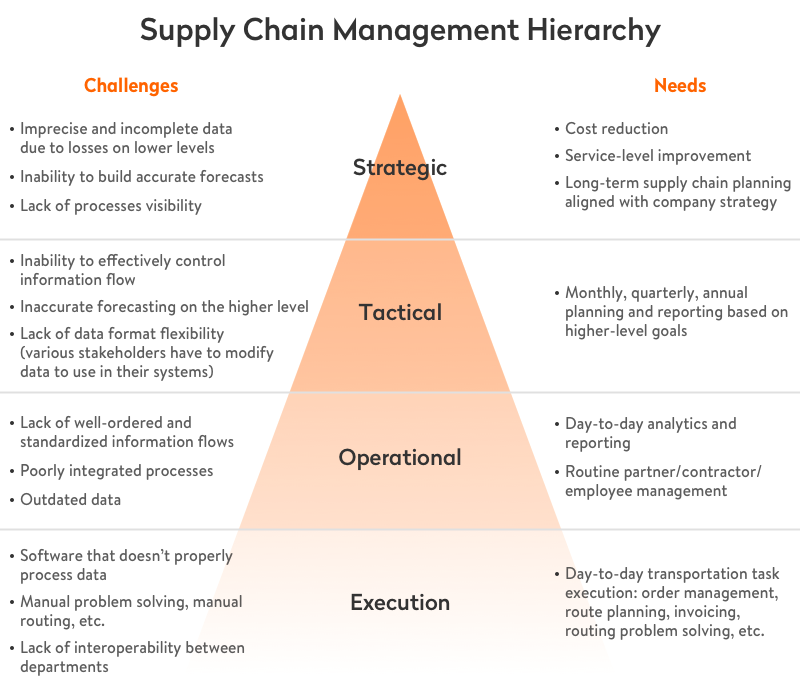
Role of root cause analysis in identifying flaws in SCM processes
Your logistics system must run like clockwork. Moreover, analysis and planning must take place at the strategic, tactical, and operational levels, which is impossible if there are flaws at any of the four levels. After all, lower levels feed data to upper levels.
If you don’t know what causes a flaw, go down to the Execution level and climb up till you identify the cause or resolve each level’s flaws step by step. If you don’t identify the true root cause, you’ll waste effort and money on false assumptions and fixing things that aren’t broken. Meanwhile, the core issue will likely still exist.
What is root cause analysis?
Root cause analysis (RCA) covers a number of techniques and tools to define the causes of problems, from pareto and fishbone diagrams to change analysis. Any RCA approach says that when you see an issue, you should move from first-level to higher-level causes to identify the root cause and fix it.
The RCA five whys approach has proven effective for defining the root causes of logistics issues. Following this approach, you should clearly define the issue you’re investigating and keep unraveling it by asking why for all further findings. The goal is to get to a presumable cause that can be traced back to the initial problem.
Use case of the five whys methodology in logistics
British pharmaceutical company GlaxoSmithKline had temperature deviation issues on their Cairo – Abu Dhabi route. To figure out the root cause of these temperature deviations and prevent them, GlaxoSmithKline used the five whys approach.
Describe the problem
GlaxoSmithKline was using air freight shipment to deliver medicines from Cairo to Abu Dhabi. But the temperature ranged from 5°C to 25°C with a service booking of 15°C to 25°C. In transit from Cairo to Abu Dhabi, the cargo had a low-temperature deviation of up to 3.9°C over 46 hours and a high-temperature deviation of up to 38°C over eight hours.
Define the root cause
Using the five whys methodology, GlaxoSmithKline’s senior supply chain integrity analyst investigated the problem to figure out the root cause of these deviations. It turned out that:
-
the Cairo ground handling team didn’t have clear instructions
-
the cargo didn’t have corresponding labels
-
the third-party logistics provider that managed the delivery used thermal covers, hiding temperature requirements
-
there was a missing lane risk assessment from Cairo to Abu Dhabi following the change to a new third-party logistics provider
-
there weren’t any temperature-controlled facilities or cool dollies in Abu Dhabi and the product was delivered by ground transportation right from the stopover in Dubai.
Adopting mitigatory measures
GlaxoSmithKline improved third-party logistics provider contracts by adding clear booking instructions. Each cargo now states the temperature range of the booking and labels are placed atop thermal blankets.
GlaxoSmithKline also performed a lane risk assessment to build a new route for cargo moving through Abu Dhabi. Any type of risk assessment now can be done using software.
You often can solve identified supply chain issues using the appropriate software. You also can add modules to existing software systems to optimize particular processes.
Let’s make a journey from the Execution level right to the Strategic. At each level, we’ll review the most common supply chain issues and their causes. We’ll also discuss the most common types of logistics software and the general modules this software contains.
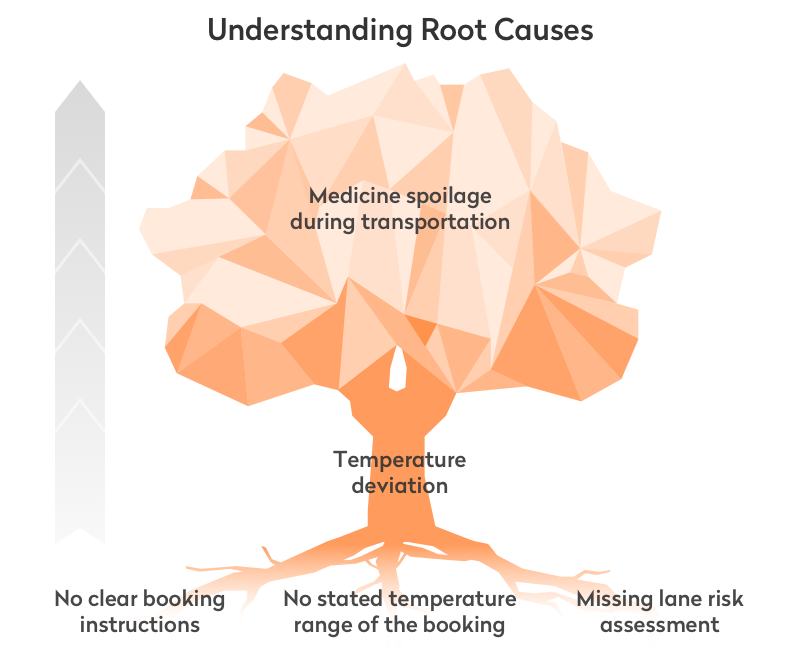
Execution level — Poor day-to-day execution of transportation tasks
A lack of lower-level process automation of transport logistics often results in lots of minor errors and delays caused by human factors and force majeure incidents. This is due to the need to manage many actors: warehouse staff, drivers, loaders, etc. The most common reasons for poor execution of day-to-day transportation tasks are the following:
Poorly integrated software
An automated management system requires lots of integrations. But each system is different. Before adding new logistics software to your system, check if it's customizable and can be properly integrated.
If it can’t, we suggest partnering with a software integration provider who has system integration engineers experienced in building outsourced custom logistics management services solutions. They’ll be able to create the integration architecture you need in the most efficient way.
Lots of manual processes
If processes such as problem-solving and routing are done manually, you’ll lose money and your service will suffer. Minimize manual processes! As a result, your logistics manager will be able to enter data for 30 minutes instead of five hours. Their time will be freed for other tasks, or you’ll need just two managers instead of six. Thereby, fewer employees will provide you with the same or a better result.
Lack of process visibility
The goal of supply chain process visibility is to enable all stakeholders, including brokers and customers, to track the state of orders, shipments, payments, and relationships with contractors and customers. Process visibility software helps you check
-
a truck’s location and predict whether the truck will be on time
-
a vehicle’s fuel consumption and when it will require maintenance and repairs
-
shipment statuses (e.g. collected by a loader, at customs)
-
invoice states (paid or unpaid)
-
relationship with partners (e.g. if a customer is expecting undelivered orders).
Supply chain visibility empowered by geofencing or cellular/satellite tracking is usually part of a transportation management system, or TMS. But a TMS system also might include plenty of other modules.
A TMS is the most commonly used software at the Execution level
Transportation management systems can differ in their components. Only route and load planning modules are mandatory. Other modules are tailored to handle particular processes or tasks.
Optional TMS technology modules
Your TMS might consist of the following modules:
Route/load planning. A route planning module allows you to build an optimal road loading plan. Scheduled routes maximize use of truck capacity and minimize distances. Load planners, in turn, consider all available cargo and build optimal shipment combinations.
AOM/DOM. Advanced order management / distributed order management tools help logistics managers decide which warehouses to ship from and to in order to save money.
Communications tool. A messaging tool enables logistics managers to connect with drivers and warehouses. It should also allow drivers to quickly notify managers about issues.
Analytics and reporting. This module allows you to measure and track performance with reports and dashboards. Dashboards summarize real-time data using graphical displays and tables.
Task management. This is a calendar where a logistics manager sees all the tasks to do and can resolve problems and create their own work plans. Warehouse workers can use this module to create specific sets of goods.
Management by exception. Management by exception requires human attention and effort. This management approach is used in cases that differ from the norm. Normal situations can be handled via standard or automated procedures. However, if something exceptional or unexpected takes place, it might require a specific action or decision from a responsible employee. Accounting specialists can identify invoice discrepancies or budget anomalies, for instance. Planning or delivery employees can see traffic or supply inventory issues. With management by exception, any employee in charge can immediately handle the problem.
Document flow/invoicing and labor management. A document flow/invoicing module allows you to send invoices with all supporting documentation right after delivery. A labor management module is literally an HR system for tracking employees’ working hours, issuing sick leave, doing payroll, etc.
To optimize your warehouse processes, you’ll need a warehouse management system (WMS).
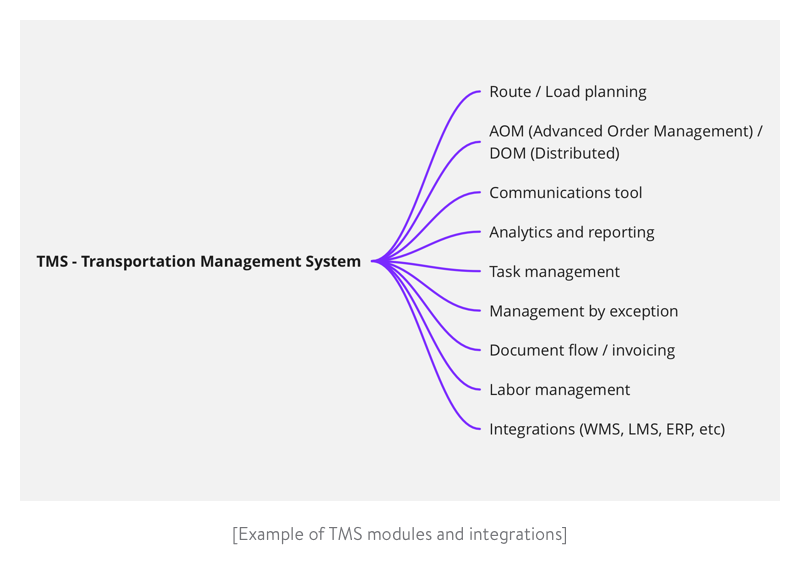
Read also: TMS Developed by Yalantis
Implementing a robust warehouse management system
A WMS provides visibility into a company’s entire inventory and handles supply chain fulfillment operations from distribution center to store shelf.
Like a TMS, a WMS should include reporting and exception management modules. But it also should have such components as:
Slotting software. This software tracks product placement and relocation. A slotting software system notifies a responsible warehouse worker if product placement isn’t logical and suggests improvements. For example, compositors commonly select sugar along with flour, which means these items should be stored nearby. As a result of slotting software, compositors will be able to pick goods faster and more effectively.
Yard management. This software helps manage the comings and goings of vehicles to and from the warehouse. For instance, yard management software can make sure a driver comes at a specific time when loaders will begin loading or unloading. Yard management software also defines the availability of parking spaces and the number of loaders.
If you’re engaged in manufacturing, you’ll need a Manufacturing Execution System (MES).
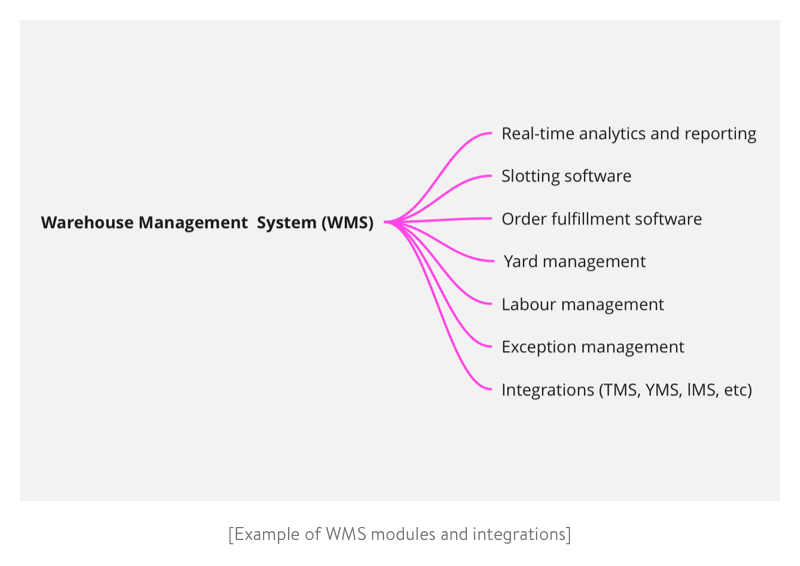
Manufacturing Execution System to manage manufacturing processes
An MES connects and monitors complex manufacturing processes.
Once you’ve automated the execution-level processes and ensured that all data is efficiently gathered at this level and flows to the upper levels in a standardized way, you can proceed to optimize the operational-level processes.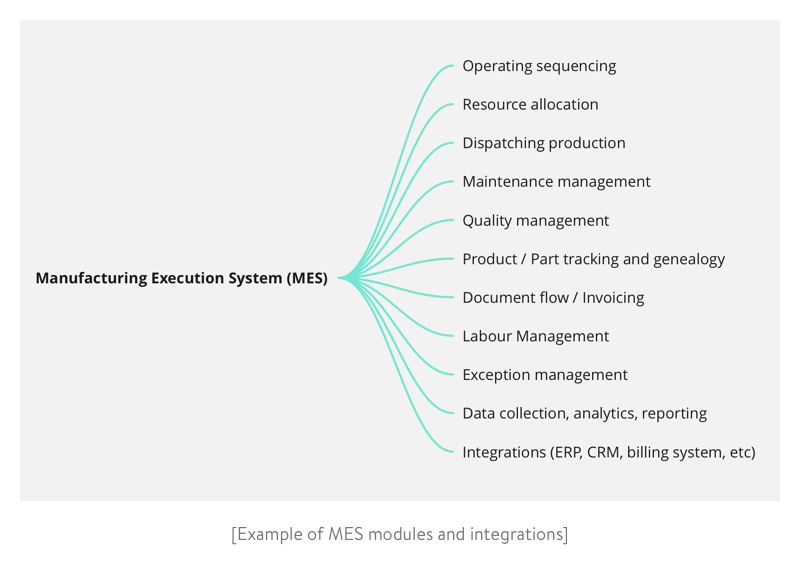
Read also: Software Used in the Logistics and Transportation Industry
Operational level — Ineffective supply chain management
An effective management software platform helps you use resources optimally, consequently saving time and money. Even a minor transportation optimization might lead to saving a great deal. What software can ensure such optimization?
Trade management software
Trade management software is usually used by importers and exporters to facilitate cooperation with trade partners and handle global trade operations. This software provides international tariff data, import and export requirements, and sanctions tools. It should also allow for managing interactions with suppliers and evaluating suppliers based on their performance.
As a result, you can know how much you’re spending on each item you take in and send out during production. Also, trade management software automates the procurement process. This results in fewer errors made and resources spent since your logistics managers can access well-ordered and standardized information and manual problem-solving is minimized.
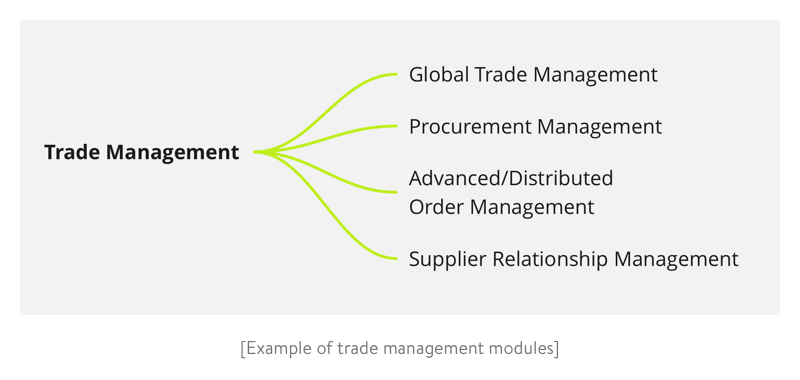
Read also: Complex Shipping Platform by Yalantis (iOS, Android, and a web-based application)
Tactical level — Inability to conduct medium-term planning and reporting
Middle management and logistics engineers need to receive monthly, quarterly, and annual reports and perform medium-term planning based on high-level goals. This can be accomplished with the following tools.
Enterprise Resource Planning / Manufacturing Resource Planning systems
Whether you need an Enterprise Resource Planning (ERP) or Manufacturing Resource Planning (MRP) system will depend on your needs. In general, if you’re searching for a solution for improving your manufacturing efforts, an MRP might be the right choice. But if you need to automate other facets of your business, including accounting and distribution, an ERP will suit you best.
An ERP/MRP system usually includes several components for comprehensive resource planning. For example, a master planning component allows companies to identify and balance the future need for raw materials and the capacity to achieve business goals.
Let’s say you’ve checked for flaws in all the levels of your supply chain management and identified the problem. It turns out that your TMS is the root of all evil. It collects imprecise and incomplete data for a month only. No wonder you can’t carry out long-term planning, as you lack enough data. Once you’ve fixed the problem, all the data smoothly flows right to the strategic level. Now you can solve the fundamental problem of your business.
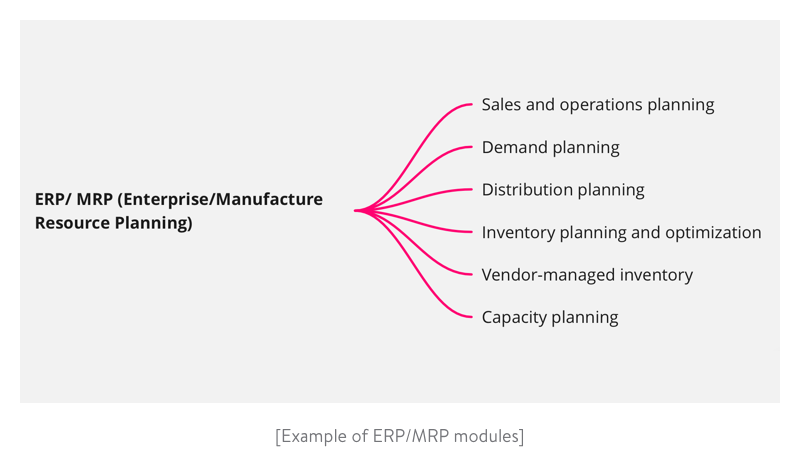
Strategic level — Lack of effective long-term predictions and planning
Once your data flows properly right to the top, you need to make it work for your business. That’s when you get to take advantage of an…
Advanced Planning and Scheduling (APS) system
An APS allows you to plan and schedule processes by taking into account production, transportation, and warehousing resources.
An APS works using algorithms and big data collected from the levels lower than the Strategic one, calculating this data, and providing you with comprehensive analytics, predictions, and suggestions. For example, an APS might detect that your annual productivity is 30 percent and suggest increasing production capacity. Or it might predict the release of resources in three months, which means you need to get the ball rolling today to find a use for them.
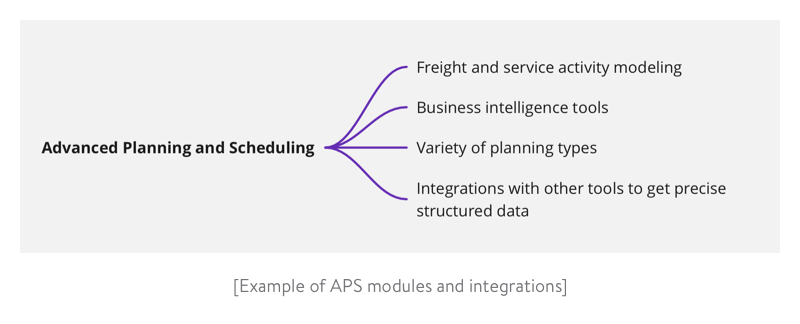
Yalantis’ approach to logistics projects
At Yalantis, we break logistics management software development into four stages.
Eliciting your business needs
To identify your business needs, we analyze your company’s processes by looking at your business from different angles. This involves:
-
defining your field of activity (which stages of the supply chain you work with)
-
identifying your business model (B2B, B2G, B2C)
-
determining which regions you operate in (domestic or international)
-
defining your type of flow: outbound or inbound (raw materials/parts or final product)
-
determining whether you’re engaged in full truckload shipping or less than truckload shipping
-
identifying your type of ownership (owned, 3PL/4PL, mixed).
Defining all stakeholders impacted by the current business process and future changes
At this step, we define your direct and indirect stakeholders, as the shipping software has to take into account all their requirements.
Examining your business processes and defining areas for improvement.
Here, we dip into all your processes step by step and dig up internal and external information flows to identify weak links.
Creating a custom solution to meet your business needs
Eventually, we select the appropriate technology stack, develop a solution, collect end-user feedback, make improvements, and train your staff and partners to use the system.
A fully customized smart logistics solution enables our clients to have:
-
transparent processes that reveal the sources of delays and errors
-
tailored software with a unique combination of modules that meet their business needs
-
all integrations needed so that data is available in different parts of the system.
Read also: Super-Fast and Secure Online Service for Reverse Logistics by Yalantis
Logistics is so complex that even with the variety of ready-made software available, you’re unlikely to find a solution that fully covers and automates all your processes. Moreover, if your potential software partner says they know what system you need without conducting thorough research into your processes, you should beat a retreat. Find a web app development and mobile app development provider who will consider your precise needs and offer a realistic solution.
Ten articles before and after
Full List of the Best Android App Development Tools in 2021
How to Use WebSockets in Go: A Comprehensive Guide
Which Tool Your Logistics App Needs: Mapbox or Google Maps Platform
Top Reasons for Cloud Migration and Step-by-Step Instructions
Six Cloud Migration Strategies Based on Yalantis’ Experience
Eight Tips on How to Ensure Core Data Migration
Best SEO Practices for React Websites
Why You Should Not Use Telegram Open Source Code
Smart Home Automation for Android on the Example of ZigBee and Z-Wave
How to Validate In-App Purchases On-Device and Through a Client’s Own Server
